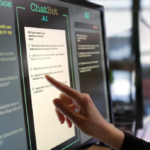The demand for skilled professionals is skyrocketing in the rapidly evolving landscape of artificial intelligence (AI). However, a critical challenge looms large—the widening gap between the skills possessed by job seekers and the requirements set by AI-driven industries.
However, a significant gap exists between the available workforce’s skills and the requirements of AI job positions. The following guide is your gateway into understanding the pressing issue: the widening gap between job seekers’ skills and what the AI job market craves.

Understand the Skill Mismatch
Getting into the world of AI jobs sounds cool, right? It is! But here’s the deal: there’s a gap between what companies want and what people have.
So, companies are on the lookout for AI pros. They need people who can work magic with technology and bring fresh ideas. The thing is, finding the perfect match is more challenging than it sounds.
AI jobs aren’t just about tech stuff like coding and algorithms. However, a significant gap emerges as job seekers need help to align their skill sets with the ever-changing requirements of AI-driven roles.
Schools and colleges often focus a lot on tech skills but not as much on soft ones. So, you get job seekers who know their tech but find the people part tricky.
In simple terms, there are many job openings, but not everyone applying fits the bill perfectly. This creates a skills mismatch—a gap between what companies need and what job seekers bring.
Stick around, and we’ll dig into how this gap affects job seekers and the companies eagerly waiting for their new AI whizzes.
Factors Contributing to the Skills Gap
Now that we know there’s a gap between what companies want and what job seekers have let’s uncover why this gap exists. It’s like playing detective, so put on your investigative hat!
1. Rapid Technological Advances
Think of technology like a speed train; it doesn’t wait. AI is evolving fast, and schools and training programs sometimes need help. This speedy tech growth means what you learn today might need an upgrade by tomorrow. It’s like trying to catch a moving target.
2. Diverse Skill Sets Required
AI applications span various sectors, from healthcare to finance, each with unique challenges and intricacies. Therefore, more than a singular skill set is needed to meet the diverse demands of these roles. Juggling all these skills is like spinning plates—tricky but necessary.
So, the skills gap is more than just a lack of technical know-how. It’s about having various skills; only some have the whole assortment.
3. Limited Hands-On Experience
Theoretical knowledge alone often needs to be improved in preparing individuals for the practical intricacies of modern job roles. The problem is that many AI courses need more hands-on experience. So, while you might ace the theory test, applying it in the real world becomes a challenge.
4. Evolving Job Descriptions
Jobs are shape-shifters in the AI world. What was hot yesterday might not be today. The result? Job descriptions become a moving target. Job seekers aim for a specific skill set, but the industry is already eyeing the next big thing. This constant change confuses both sides, contributing to the skills gap.
5. Limited Access to Resources
Imagine wanting to learn a new dance, but the dance floor is far away. That’s how it feels for some folks wanting to dive into AI. Access to resources—like good courses, mentors, and real-world projects—can be limited. Not everyone has the same dance floor, creating inequality in skill-building opportunities and widening the skills gap.

Addressing the Gap: Strategies for Success
This gap, whether in technology, leadership, or other specialized fields, poses challenges for individuals seeking to thrive in their careers and organizations aiming to stay competitive.
1. Enhancing Education and Training Programs
Let’s revamp the school books and online courses. Make them align with the speedy tech world. If AI is running, our education needs to keep pace. Up-to-date learning materials mean job seekers are better prepared for the real AI game.
2. Industry-Academia Partnerships
Teamwork makes the dream work. Schools and companies need to shake hands. Bring real-world problems into classrooms. Let students taste the actual flavor of AI challenges. This collaboration helps students understand what’s needed in the job market.
3. Upskilling and Reskilling Initiatives
Think of it as a power-up for current professionals. Invest in programs that teach new AI tricks to the folks already in the game. It’s not just for fresh faces; even experienced players need a skill boost occasionally.
4. Rethinking Recruitment Strategies
Companies, listen up. It’s not just about degrees and diplomas. Look beyond the paper—spot potential and willingness to learn. Sometimes, the best AI minds come in a different package.
5. Cultivating a Learning Culture
Make learning part of the job. Encourage employees to keep growing. It’s not a one-time thing; it’s a continuous journey. A workplace that values learning creates AI superheroes in the long run.
6. Mentorship Programs
Imagine having a wise friend showing you the ropes. That’s what mentorship does. Seasoned pros guide newbies, sharing their wisdom. It’s like having a GPS for the AI journey, helping you avoid bumps and find a smooth path.
7. Government Initiatives
Governments, play your part. Support education, fund programs, and create an environment where AI can thrive. Policies that nurture AI skills benefit everyone, creating a pool of talented individuals ready to tackle the evolving job market.
These strategies are like tools in a handyman’s kit. Governments can initiate reforms in educational systems, ensuring that curricula align with industry needs. Educational institutions can better prepare students for evolving job requirements by incorporating up-to-date content and practical training.

The Role of Employers in Mitigating the Gap
Alright, employers, you’re not just bystanders in this skills gap situation. Here are seven practical ways you can play a superhero role in bridging the gap in the AI job market.
1. Rethinking Recruitment Strategies
Look beyond the paper. Degrees and diplomas are cool, but don’t let them be the sole judge. Spot potential and willingness to learn. Sometimes, the best AI minds come in a different package.
2. Cultivating a Learning Culture
Make learning part of the job. Encourage employees to keep growing. It’s not a one-time thing; it’s a continuous journey. A workplace that values learning creates AI superheroes in the long run.
3. Mentorship Programs
Think of it like having a wise friend at work. Seasoned pros guide newbies, sharing their wisdom. It’s like having a GPS for the AI journey, helping you avoid bumps and find a smooth path.
4. Offering Professional Development Opportunities
Don’t just stop at hiring. Invest in your team. Employers often provide in-house training programs focusing on specific skills relevant to the organization’s industry. These can range from technical to soft skills such as communication and leadership.
5. Internship and Training Programs
It’s like a pre-job adventure. Bring in interns let them get their hands dirty. Offer training programs to get them up to speed. It’s a win-win; they learn, and you might find your next AI superstar.
6. Flexible Job Requirements
Be open-minded. It’s about more than ticking all the boxes. Be flexible with job requirements. Look for potential and eagerness to adapt. Sometimes, the perfect fit isn’t the one you expected.
7. Recognizing and Rewarding Potential
Spot talent early. If someone shows promise, acknowledge it. Rewards don’t always have to be big; sometimes, a pat on the back or a shout-out in a meeting can do wonders. Recognition fuels motivation.
How AI is Bridging the Gap Between Talent and Job Requirements
AI isn’t just creating the gap; it’s also part of the solution. Let’s dive into how Artificial Intelligence is stepping up to bridge the divide between job seekers’ skills and what employers need in the AI job market.
1. Automated Learning Platforms
Imagine having a personal AI tutor. Automated learning platforms use AI to understand your learning style and adapt the content accordingly. They cater to individual needs, helping learners grasp AI concepts at their own pace.
2. AI-Powered Skill Assessment Tools
Think of it as a digital skills Olympics. AI tools assess your skills objectively, without bias. They provide instant feedback, helping job seekers understand where they stand and what areas need more polishing.
3. Virtual Reality (VR) Simulations
It’s like a practice field for AI enthusiasts. AI-powered VR simulations allow individuals to apply their knowledge in realistic scenarios. It’s not just theory; it’s hands-on experience in a virtual world.
4. AI-Driven Personalized Learning Paths
Some learn differently. AI tailors learning paths based on individual strengths and weaknesses. It’s like having a customized roadmap to AI expertise, ensuring that no one is left behind.
5. AI-Powered Recruitment Tools
Employers, meet your AI assistant in hiring. These tools analyze resumes, assess candidates, and even conduct initial interviews. It streamlines the hiring process, helping companies identify the right talent more efficiently.
6. Predictive Analytics for Skills Forecasting
It’s like having a crystal ball for job skills. Predictive analytics powered by AI analyze trends to predict future skill requirements. This helps individuals and institutions stay ahead, preparing for the skills that will be in demand.
Conclusion:
As we wrap up this exploration, one thing is clear: bridging the skills gap requires a collective effort. From individuals’ upskilling to employers’ rethinking hiring strategies, everyone has a role. During this, iApply emerges as a beacon—a platform that understands the unique needs of the AI job market.
With user-friendly features and a knack for connecting talent with opportunity, iApply stands out as the go-to platform for navigating the dynamic landscape of AI jobs.









